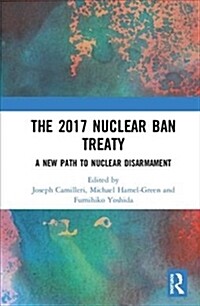
The 2017 Nuclear Ban Treaty: A New Path to Nuclear Disarmament
- 발행사항
- United Kingdom: 2019
- 형태사항
- 284 p. ; 25 cm
- ISBN
- 9781138393547
- 청구기호
- 349.82 C183t
- 서지주기
- Includes bibliographical references and index
소장정보
| 위치 | 등록번호 | 청구기호 / 출력 | 상태 | 반납예정일 |
|---|---|---|---|---|
이용 가능 (1) | ||||
| 1자료실 | 00017058 | 대출가능 | - | |
- 등록번호
- 00017058
- 상태/반납예정일
- 대출가능
- -
- 위치/청구기호(출력)
- 1자료실
책 소개
Rising concern over the increasing threat of nuclear war impelled the 2017 United Nations (UN) negotiations and adoption by 122 UN member states of a Treaty on the Prohibition of Nuclear Weapons. The Treaty seeks to ban nuclear weapons globally in the same way chemical and biological weapons have already been prohibited. This book provides the first in-depth comprehensive analysis of the implications and possibilities of the new treaty, drawing on the insights of international relations, international laws, and disarmament experts and specialists from Europe, America, the Asia-Pacific, and the UN. In a context where existing nuclear weapon states have so far declined to be party to the new treaty, the book examines not only its emergence and significance but also the prospects and possibilities for its implementation, the challenges associated with verifying the new agreement, the role of both civil society and governments, and the treaty’s wider implications in addressing regional and global nuclear threats.
This book was originally published as a special issue of Global Change, Peace & Security but additionally includes the special section articles on the treaty in the Journal for Peace and Nuclear Disarmament.
This book analyses the implications of the new UN Nuclear Weapon Ban Treaty. Most of the chapters were originally published in a special issue of Global Change, Peace and Security, but the book also includes the special section articles on the treaty in the Journal for Peace and Nuclear Disarmament, and a new introduction and conclusion.
목차
Introduction - Rethinking the path to nuclear disarmament Joseph A. Camilleri, Michael Hamel-Green and Fumihiko Yoshida
Part 1: Nuclear Ban Treaty: Rationale and Significance
1. Obstacles to understanding the emergence and significance of the treaty on the prohibition of nuclear weapons John Borrie, Michael Spies and Wilfred Wan
2. A ‘light for all humanity’: the treaty on the prohibition of nuclear weapons and the progress of humanitarian disarmament Bonnie Docherty
3. The diplomacy of resistance: power, hegemony and nuclear disarmament Nick Ritchie and Kjølv Egeland
4. Stigmatizing and Delegitimizing Nuclear Weapons Mitsuru Kurosawa
5. A Strategic Plan for Nuclear Disarmament: Engineering a Perfect Political Storm Randy Rydell
Part 2: The Role of Civil Society
6. Negotiating the UN treaty on the prohibition of nuclear weapons and the role of ICAN Tilman Ruff
7. The ICRC and the Red Cross and Red Crescent Movement: Working Towards a Nuclear-Free World since 1945 Linh Schroeder
8. Why youth and feminist activism matters: insights from anti-nuclear campaigns in practice Lisa Carson
9. Impacts of the nuclear ban: how outlawing nuclear weapons is changing the world Ray Acheson
Part 3: Verification
10. Verification and security of transformation to a nuclear-weapon-free world: the framework of the Treaty on the Prohibition of Nuclear Weapons Jurgen Scheffran
11. An international monitoring system for verification to support both the treaty on the prohibition of nuclear weapons and the nonproliferation treaty Tamara Patton
Part 4: National and Regional Perspectives
12. Japan and the Nuclear Weapons Prohibition Treaty: The Wrong Side of History, Geography, Legality, Morality, and Humanity Ramesh Thakur
13. Ban Treaty: will it abolish nuclear weapons? A Japanese perspective Nobuyasu Abe
14. Nuclear non-proliferation and disarmament at the crossroads ? a Mongolian perspective Enkhsaikhan Jargalsaikhan
15. The implications of the 2017 UN Nuclear Prohibition Treaty for existing and proposed nuclear-weapon-free zones Michael Hamel-Green
Conclusion - Concluding Reflections: The long journey ahead Joseph A. Camilleri
